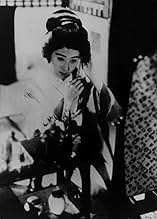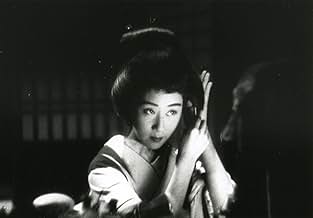Gion no kyôdai
- 1936
- 1h 9min
CALIFICACIÓN DE IMDb
7.4/10
3.2 k
TU CALIFICACIÓN
Dos hermanas geishas llevan una vida difícil en el distrito de Gion de Kioto. Cuando una de ellas se siente obligada a ayudar a un empresario en bancarrota, la otra hermana pone en marcha va... Leer todoDos hermanas geishas llevan una vida difícil en el distrito de Gion de Kioto. Cuando una de ellas se siente obligada a ayudar a un empresario en bancarrota, la otra hermana pone en marcha varios planes para deshacerse de él.Dos hermanas geishas llevan una vida difícil en el distrito de Gion de Kioto. Cuando una de ellas se siente obligada a ayudar a un empresario en bancarrota, la otra hermana pone en marcha varios planes para deshacerse de él.
- Dirección
- Guionistas
- Elenco
- Premios
- 1 premio ganado en total
Namiko Kawashima
- Oemi Furusawa
- (as Kazuko Kuno)
Fumio Ôkura
- Jurakudo, the antiques dealer
- (as Fumio Okura)
- Dirección
- Guionistas
- Todo el elenco y el equipo
- Producción, taquilla y más en IMDbPro
Opiniones destacadas
In the early days of film writing "Sisters" was often cited as one of the great films EVER; it is probably right that this quiet, measured film is now not viewed as such.
Still, I found it held my interest easily and was effecting. The acting is admirable, and the sadness of the women's plight are expressed without sentiment. Well worth seeing; 8 out of 10.
Still, I found it held my interest easily and was effecting. The acting is admirable, and the sadness of the women's plight are expressed without sentiment. Well worth seeing; 8 out of 10.
The characters in Sisters of Gion are trapped, but like many women in a Japan of that era, which was... well, for a while up until 1936 and beyond. Particularly that of the Geisha, whose lives would have to revolve around men who would want them to "do things" for them; not simply sexual, though there was that, but just to take care of them, and buy things for them, etc. So in this story, Mizoguchi has a character, Omocha (Isuzu Yamada) who looks at her lot and life and doesn't like it, and tries to tell her much more submissive sister Umekichi the same. So she spends most of this story swindling a guy with a kimono mostly at the expense of a lower-rung guy who is staying with them, Furusawa, who lost his business. Not so much cause she's a bad person (she isn't) but just as the guy and who he's with kind of deserve it.
The story moves along at a fairly good pace, especially considering how short it is at 69 minutes (though according to IMDb the version available through the Eclipse DVD series is the shortened cut, a few times it does show), and it's pretty good... not great, mind you, but good. Some, or I should say most, of the dialog is a little too on-the-nose about the points it wants to make, even near the end when Mizoguchi really gains momentum with his story and the male-female dynamics of this society. And yet by the end it is powerful and moving, in some part because of how strongly he directs the film; those shots that kind of take deep focus looking down an alleyway that is kind of narrow, closing in on the characters, or how long he stays on a shot (he was all about the long takes too), almost like there's no escape for these girls.
So, do come for the feminism on display, which could be seen as overwrought or dated but only because it's 1936 and for its time is powerful - and stay for some elegant direction, some wonderful acting (watch the scene where Omocha has the guy over who is there on official matters, kind of to scold him for how she treated his employee, but then softens up when she serves Sake), and a couple of moments of good music, however sparse. 7.5/10
The story moves along at a fairly good pace, especially considering how short it is at 69 minutes (though according to IMDb the version available through the Eclipse DVD series is the shortened cut, a few times it does show), and it's pretty good... not great, mind you, but good. Some, or I should say most, of the dialog is a little too on-the-nose about the points it wants to make, even near the end when Mizoguchi really gains momentum with his story and the male-female dynamics of this society. And yet by the end it is powerful and moving, in some part because of how strongly he directs the film; those shots that kind of take deep focus looking down an alleyway that is kind of narrow, closing in on the characters, or how long he stays on a shot (he was all about the long takes too), almost like there's no escape for these girls.
So, do come for the feminism on display, which could be seen as overwrought or dated but only because it's 1936 and for its time is powerful - and stay for some elegant direction, some wonderful acting (watch the scene where Omocha has the guy over who is there on official matters, kind of to scold him for how she treated his employee, but then softens up when she serves Sake), and a couple of moments of good music, however sparse. 7.5/10
Mizoguchi creates a tiny universe with a few characters that somehow manages to maintain in balance throughout the entire film. This is achieved because every character feels real, that means they can be right and wrong and there is not a single character that has the absolute truth.
Very simple filmmaking precisely thought out. With no ostentation the director decides to stay in the shade and put the story and characters in the spotlight.
After watching It on DVD a couple of years ago, I got to see It on the big screen thanks to the Bilbao Art House Zinema.
After watching It on DVD a couple of years ago, I got to see It on the big screen thanks to the Bilbao Art House Zinema.
When reviewing Kenji Mizoguchi's 'Sisters of the Gion', the first and foremost thing that I have to talk about is the film's portrayal of exploited women and their sorry plight. For a film made in 1936, the film is astonishingly progressive. Mizoguchi leaves no stone unturned in showing the viewer how tough the life of a geisha was. The men whom we see engage with the sisters Omocha and Umekichi, though played by different actors are made to look very similar appearance wise and I think that was a specific choice on the part of Mizoguchi. Mizoguchi's approach to telling this story has a distinct boldness to it with a hopelessness simmering underneath. The protagonist Omocha is not a submissive character whose pain and suffering is supposed to convey the message. Instead, she is a feisty pragmatic rebel who played the game the way it is without being obstructed by any sense of morality. The feminist message is supposed to be conveyed by the fact that even fighting the system isn't enough to escape the exploitation and the abuse. These women would still continue to be treated as commodities.
What struck me about Mizoguchi's direction and visual style is his meticulous use of space in a particular frame. He sits on a frame, there is very minimal editing and he uses tracking shots quite a bit. He uses the 'frame within a frame' composition(also found in Renoir's films) quite a bit by placing characters in the background while others being in the foreground and pretty much each and every one of these visual choices serves a thematic purpose, be it conveying the difference in mindsets of Omocha and Umekichi or showing a man being lured in by Omocha's manipulation,etc. Another thing I noticed is Mizoguchi's reluctance in using too many close-ups. The close-ups in the film are used very sparsely and economically.
Due to its runtime, the film is a little light on character development or backstory, but the nuanced nature of using visuals to tell a story really impressed me. It is clear in its agenda and Mizoguchi is bold enough to express his ideas with conviction.
What struck me about Mizoguchi's direction and visual style is his meticulous use of space in a particular frame. He sits on a frame, there is very minimal editing and he uses tracking shots quite a bit. He uses the 'frame within a frame' composition(also found in Renoir's films) quite a bit by placing characters in the background while others being in the foreground and pretty much each and every one of these visual choices serves a thematic purpose, be it conveying the difference in mindsets of Omocha and Umekichi or showing a man being lured in by Omocha's manipulation,etc. Another thing I noticed is Mizoguchi's reluctance in using too many close-ups. The close-ups in the film are used very sparsely and economically.
Due to its runtime, the film is a little light on character development or backstory, but the nuanced nature of using visuals to tell a story really impressed me. It is clear in its agenda and Mizoguchi is bold enough to express his ideas with conviction.
This film is about geishas on Kyoto, Japan, in how they live and ply their trade. Since it was made by Mr. Mizoguchi, who seemed to have a fascination with prostitutes, it is right up his alley. While good, the story did not completely grab me like some of his others, especially "Street Of Shame" and "Ugetsu". The film's success is in the message it portrays as to these ladies, that they are somewhat trapped in their existence with no way out, broke and looking for a patron to take them out of that life. However, I did not find the characters to be as developed as I would have liked, so the film loses steam, even though it is a fairly short film, much less than ninety minutes. Still worth watching, it just doesn't have the depth of some of his other films.
¿Sabías que…?
- TriviaDaiichi Studio went into bankruptcy following the poor commercial results of the film.
- ConexionesReferenced in Aru eiga-kantoku no shôgai (1975)
Selecciones populares
Inicia sesión para calificar y agrega a la lista de videos para obtener recomendaciones personalizadas
Detalles
- Fecha de lanzamiento
- País de origen
- Idioma
- También se conoce como
- Sisters of the Gion
- Productora
- Ver más créditos de la compañía en IMDbPro
Taquilla
- Total a nivel mundial
- USD 17,807
- Tiempo de ejecución1 hora 9 minutos
- Color
- Relación de aspecto
- 1.37 : 1
Contribuir a esta página
Sugiere una edición o agrega el contenido que falta

Principales brechas de datos
By what name was Gion no kyôdai (1936) officially released in Canada in English?
Responda



















